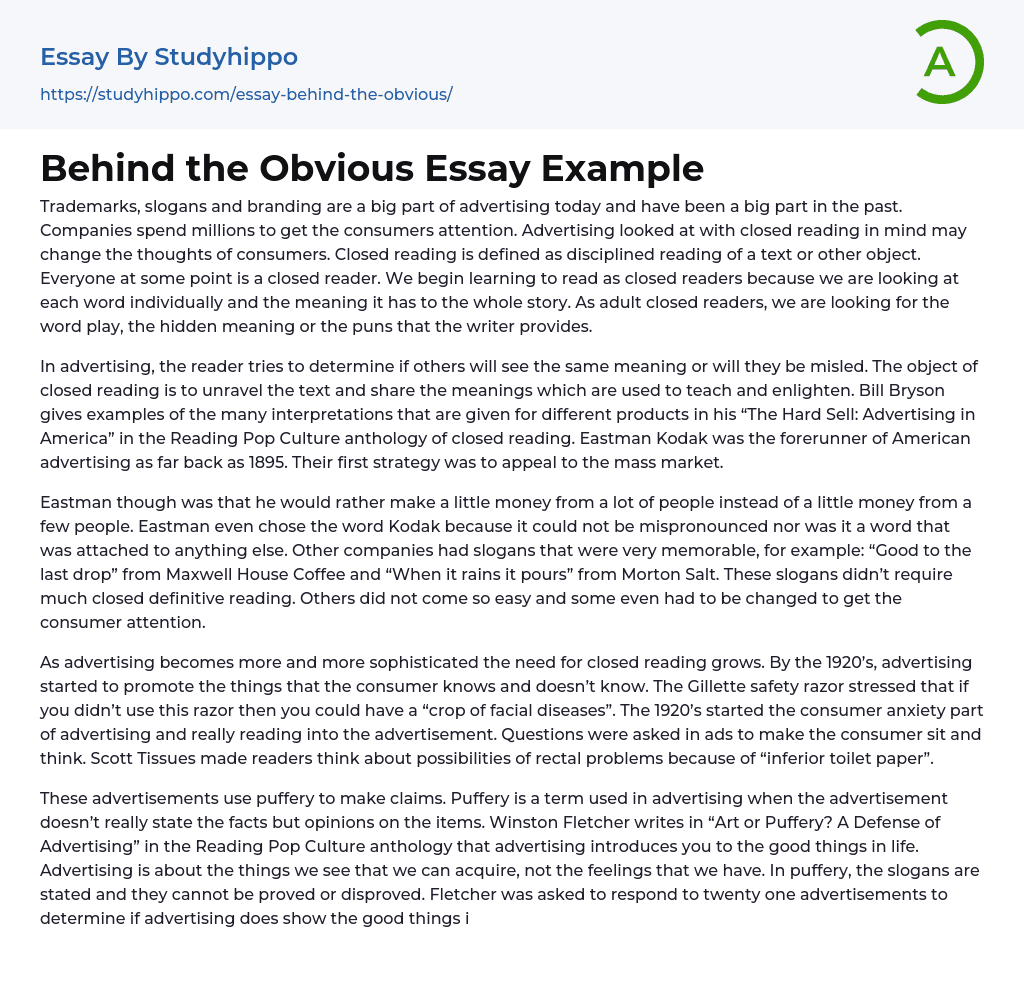In today's advertising landscape, trademarks, slogans, and branding play a significant role. This has also been the case in the past, as companies invest millions to capture consumer attention. Taking a closer look at advertising can potentially alter consumer perspectives. The concept of closed reading refers to a disciplined approach to analyzing texts or objects. We all start as closed readers when we learn to read, carefully examining each word and its contribution to the overall narrative. As adults, we engage in closed reading to uncover word play, hidden meanings, or puns that writers incorporate into their work.
The purpose of advertising is to determine if others will perceive the same meaning or if they will be deceived. Closed reading aims to analyze the text and communicate the meanings it conveys for educational and e
...nlightening purposes. In “The Hard Sell: Advertising in America” by Bill Bryson, included in the Reading Pop Culture anthology of closed reading, various interpretations for different products are provided. Eastman Kodak, which dates back to 1895, was a pioneer in American advertising. Their initial approach was to target the general public.
The rationale behind Eastman's decision was that he preferred to earn small profits from a large customer base rather than small profits from a limited number of customers. Additionally, Eastman intentionally selected the name Kodak because it couldn't be mispronounced and wasn't associated with any other meaning. Unlike other companies' catchy slogans such as "Good to the last drop" by Maxwell House Coffee and "When it rains it pours" by Morton Salt, which didn't require much interpretation, some slogans required more effort to understand and even had t
be modified to capture consumers' attention.
With the increasing sophistication of advertising, there is a growing need for careful analysis. During the 1920s, advertising began to highlight both the known and unknown aspects of products. For instance, the Gillette safety razor emphasized that not using their razor could lead to facial diseases. This was a time when consumers were encouraged to critically examine advertisements and ask themselves questions. Scott Tissues, for example, encouraged readers to consider the potential rectal problems that could arise from using "inferior toilet paper".
These advertisements employ puffery to make claims. Puffery refers to the use of opinions rather than facts in advertising. In his article "Art or Puffery? A Defense of Advertising" in the Reading Pop Culture anthology, Winston Fletcher argues that advertising introduces us to the desirable aspects of life. It focuses on the tangible possessions we can acquire, rather than our emotions. Puffery involves the use of slogans that cannot be proven or disproven. To assess whether advertising truly showcases the good things in life, Fletcher was asked to evaluate twenty-one advertisements.
In defense of advertising, Fletcher argues that advertisements cannot include all the facts about a product. Advertisers select the best facts when creating an advertisement. Fletcher mentions other viewpoints from advertising critics but ultimately finds that more than 80% of the British population believes that advertising is beneficial. Advertising can be a positive influence, but consumers should carefully analyze the underlying message in an advertisement and decide for themselves the extent of exaggeration.
- Sales Promotion essays
- Advertising campaign essays
- Money essays
- Financial Accounting essays
- Market Segmentation essays
- Supply And Demand essays
- Purchasing essays
- Forecasting essays
- Legacy essays
- Bank essays
- Corporate Finance essays
- Financial News essays
- Financial Ratios essays
- Financial Services essays
- Free Market essays
- Shareholder essays
- Personal finance essays
- Equity essays
- Financial Crisis essays
- Banking essays
- Credit Card essays
- Currency essays
- Debt essays
- Gold essays
- Loan essays
- Enron Scandal essays
- Foreign Exchange Market essays
- Investment essays
- Venture Capital essays
- Stock Market essays
- Retirement essays
- Donation essays
- Net Present Value essays
- Income Statement essays
- Commercial Bank essays
- Debit Card essays
- Deposit Account essays
- Subprime Lending essays
- Perfect Competition essays
- Underwriting essays
- Synergy essays
- Valuation essays
- Investing essays
- Asset essays
- Depreciation essays
- Discounted Cash Flow essays
- Foreign Direct Investment essays
- Funds essays
- Internal Rate Of Return essays
- Revenue essays




